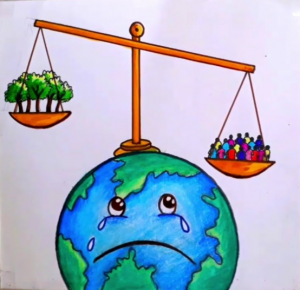DEBAJYOTI CHAKRABORTY
KOLKATA, 11 JULY 2022
On the World Population Day today, the United Nations has projected India to be the most populous city on earth surpassing China within a year.
In 2011, the world reached a population of 7 billion. This year, the number will hit 8 billion, prompting the attendant responses, according to the United Nations.
The World Population Prospects 2022 report released on the occasion by the United Nations Department of Economic and Social Affairs , Population Division, indicates that the global projected population will be eight billion on November 15,2022.

The theme of World Population Day 2022 : “A world of 8 billion: Towards a resilient future for all – Harnessing opportunities and ensuring rights and choices for all.”
“Reaching a global population of eight billion is a numerical landmark, but our focus must always be on people. In the world we strive to build, 8 billion people means 8 billion opportunities to live dignified and fulfilled lives.,” says UN Secretary-General António Guterres.
The WORLD POPULATION DAY ( 11 JULY) event was established by the Governing Council of the United Nations Development Programme in 1989.
The UN report says ,it took hundreds of thousands of years for the world population to grow to 1 billion – then in just another 200 years or so, it grew sevenfold. In 2011, the global population reached the 7 billion mark, it stands at almost 7.9 billion in 2021, and it’s expected to grow to around 8.5 billion in 2030, 9.7 billion in 2050, and 10.9 billion in 2100.
This dramatic growth has been driven largely by increasing numbers of people surviving to reproductive age, and has been accompanied by major changes in fertility rates, increasing urbanization and accelerating migration. These trends will have far-reaching implications for generations to come.
The recent past has seen enormous changes in fertility rates and life expectancy. In the early 1970s, women had an average of 4.5 children each; by 2015, total fertility for the world had fallen to below 2.5
children per woman. Meanwhile, average global life spans have risen, from 64.6 years in the early 1990s to 72.6 years in 2019.
In addition, the world is seeing high levels of urbanisation and accelerating migration. 2007 was the first year in which more people lived in urban areas than in rural areas , and by 2050 about 66 per cent of the world population will be living in cities.
Globally, this day is celebrated by organising seminars, discussions, educational sessions, public contests, slogans, workshops, debates, songs, etc.
“ On World Population Day, let’s focus on every person. On ensuring our world can support our needs and those of future generations. On protecting human rights and the ability of all individuals to make informed choices about whether and when to have children. On leaving no one behind,”tweeted UN Secretary General, Antonio Gueterres.
Eastern and South eastern Asia are the world’s most populous regions in 2022, with 2.3 billion people which is almost 29 percent of the total human population and Central and Southern Asia with 2.1 billion which is about 26 percent of the global population, the UN study says.
India and China each contribute about 1.4 billion population in 2022. The current population of India is 1.412 billion compared to 1.426 billion of China. The projected population of India in 2050 will be 1.668 billion , which is way ahead of China with 1.317 billion, the report says.

Advertisement:





























Add Comment